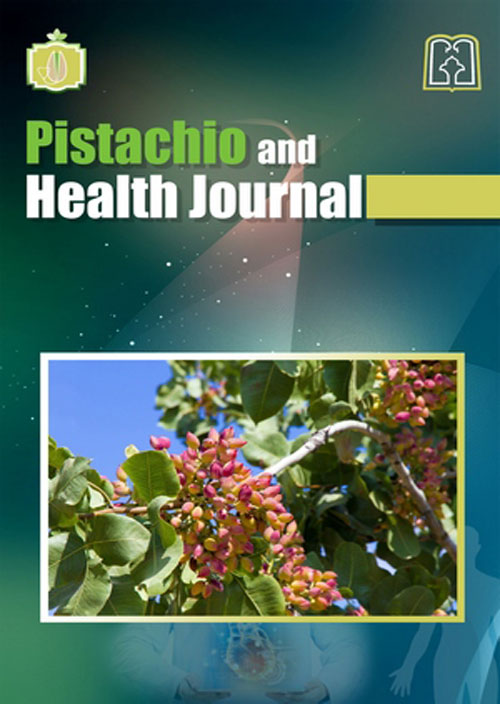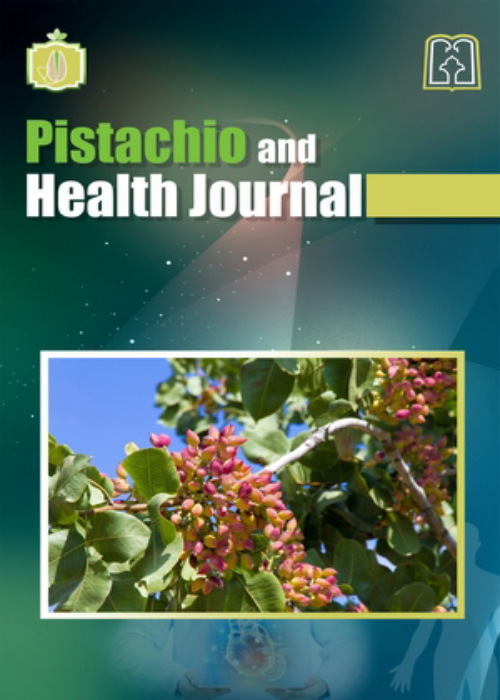فهرست مطالب

Pistachio and Health Journal
Volume:2 Issue: 4, Autumn 2019
- تاریخ انتشار: 1398/09/10
- تعداد عناوین: 7
-
-
Pages 4-15Introduction
Pistachio contains compounds with antioxidant activity. Due to the high phenolic and antioxidant content of different parts of pistachio, including leaves, gum, pericarp, and seed, researchers have concentrated on this plant to research its anti-cancer activity. This paper aims to investigate the anti-proliferation effect of pericarps and kernels of P. vera var. akbari on the PC-3 prostate cancer cells.
Materials and MethodsIn this study, the effect of hydroalcoholic extract of pistachio pericarps and kernels on the proliferation of prostate cancer cells was measured by (3-(4,5-dimethylthiazol-2-yl)- 2,5-diphenyltetrazolium bromide (MTT) assay. For this purpose, culture media of prostate cancer cells were treated with final doses (0, 0.1, 0.5, 1, 2.5, 5, 10 mg/mL) of extract for 24, 48, and 72 h, and the IC50 values were measured. All experiments were performed in triplicate with three replications.
ResultsThis research results indicated that both extracts reduced cell viability in cancerous cells in a dose- and time-dependent manner significantly. The IC50 values of the hydroalcoholic extract of pistachio pericarp against PC-3 prostate cancer cells after 48 h and 72h treatment were 8.73 and 4.24 mM, respectively. However, these values for pistachio kernel extract were 6.52, 4.72, and 4.41 mM, respectively. Data were analyzed by a one-way ANOVA, and a value of P<0.05 was considered statistically significant.
ConclusionThe results demonstrate the anti-cancer activity of pistachio seed and pericarp on human prostate cancer cells in in vitro. The anti-carcinogenesis effects of pistachio are probably related to the presence of a considerable number of biologically active components, including phenolic compounds with antioxidant properties.
Keywords: prostate cancer cells, Pistachio Pericarp, anti-cancer activity, Pistachio Kernel -
Pages 16-26
In the resent years, unique insights have been gained into the possible role of the pistachio nut in maintaining health and preventing many diseases. Many studies have been carried out to evaluate the possible effect of nut intake on body composition, metabolic, inflammatory, and oxidative stress parameters. As pistachio nuts are so very rich in fat content that can be oxidized, their skin contains many antioxidants. The in vivo experiments carried out in humans on the impact of pistachio nuts on human health are reviewed in this study.
Keywords: Pistachio nut, Nutritional Elements, Health -
Pages 27-42
Honey, as a nutraceutical and a functional substance, plays the role of a sweetener and has an impact on rheological characteristics, including flow properties and viscosity. This study aims to critically review the importance of honey and its uses in terms of rheological properties in nut butters, spreads, and pastes. A total of 49 reviews published in major food and science journals were assessed in this review article to study their methods. Assessments were made based on some explicit criteria of information synthesis. Research indicates the useful role of honey in the food industry, especially in nut butters, spreads, and pastes through imparting desired texture and rheological properties. Nuts and their related products have received much attention in developing a healthy lifestyle. Accordingly, they are commonly used, apart from in a natural form, as ingredients in various processed foods, such as confectionery and bakery products as pastes and spreads. Rheological properties can improve processing and end-use quality. Understanding rheology of foodstuffs is effective in predicting long-term stability of products, especially that of plantbased oils.
Keywords: Butter, honey, Nuts, Rheology, Spreads -
Pages 43-52Introduction
Cutaneous leishmaniasis is one of the endemic parasitic diseases in central Iran. The rural type of this disease is transmitted from rodents to humans by Phlebotomus papatasi. This study aims to investigate the role of vegetation in the existence of rodents in the study area.
Materials and MethodsThe current descriptive-analytical study investigates prevalence of leishmaniasis in the Esfandabad Abarkooh City from 2019 to 2020. ArcGIS 10.2.2 and the layer overlay technique were used to examine effects of vegetation on the development of rodent activity, being regarded as leishmania reservoirs
ResultsA total of 20 and 23 cases of leishmaniasis were diagnosed in 2019 and in the first seven months of 2020, respectively. The findings revealed that the primary vegetation of the Esfandabad Abarkooh City included two species of Atriplex and pistachios. The layer overlay technique and the areas containing rodent nests showed that Atriplex encompassed 81.45% of the nests, and only 0.37% of the active nests were found in pistachio fields.
ConclusionIn addition to preventing soil erosion, pistachio cultivation has a significant role in reducing rodent activity in the region. In addition, it positively impacts the residents' economy through its positive role in sustainable development in the region.
Keywords: Leishmaniasis, Pistachio, Atriplex, Geographic information systems -
Pages 53-72Introduction
The predatory ladybeetle, Oenopia conglobata contaminata (L.) (Col. Coccinellidae), is an important coccinellid predator of the common pistachio psylla, Agonoscena pistaciae Burckhardt and Lauterer (Hem.: Psyllidae). Given public concerns about reducing dependence on chemical pesticides in pistachio orchards, the use of biological control agents is attracting growing attention.
Materials and MethodsIn this study, effects of spirotetramat, fenitrothion, and chlorpyrifos (350, 40, and 10 ml/L, respectively) on some biological and life history parameters of O. conglobata contaminata fed on the common pistachio psylla were examined under controlled conditions (25 ± 1°C, 60 ± 5% RH, and 16:8 h L: D photoperiod). Accordingly, eggs of O. conglobata contaminata were exposed to pesticides by a dipping method.
ResultsThe results revealed that spirotetramat, fenitrothion, and chlorpyrifos decreased the development time and total longevity in O. conglobata contaminata adults. The highest and lowest fecundity rates were observed in spirotetramat and fenitrothion treatments, respectively. The treatments of insecticides exerted adverse effects on life history parameters of O. conglobate contaminata. The highest values of r, R0, 𝜆, and GRR were obtained in the spirotetramat treatment, whereas the lowest values of these population parameters were recorded in the fenitrothion treatment.
ConclusionThe results suggest that spirotetramat could be effective in O. conglobata contaminata in an IPM program.
Keywords: Chlorpyrifos, Coccinellidae, Fenitrothion, Life table, Spirotetramat -
Pages 73-82Introduction
The delicacy, easy digestion, and nutritional value (e.g., high calories, vitamins, and minerals) are some characteristics that distinguish pistachios from other tree nuts. This research explores the replacement of the date powder of Ghasab cultivar with sugar in the formula of pistachio butter.
Materials and MethodsThe date powder was substituted by 0, 25, 50, 75, and 100% sugar in the formulation of pistachio butter. In this field, a factorial experiment was used in a completely randomized design. Also, the time of mixing pistachio paste and sugar or date powder (3, 5, 7, and 9 h) in a ball mill was investigated. The pistachio butter formulas were stored at 20°C for 6 months. During storage, physicochemical tests (oil separation, peroxide value, and free fatty acid content) and sensory evaluation (in terms of taste, texture, and color) were carried out.
ResultsThe more the mixing time, the better the product was obtained. However, no significant difference (P≤ 0.05) was observed between mixing times of the raw materials (3, 5, 7, and 9 h). The free fatty acid amount and peroxide value were in the range of 0.4- 0.8% and 4.7 - 4.9 mEq.kg, respectively. The pistachio butter with 100% date powder showed a lower percentage of separated oil than that with 25% date powder or without.
ConclusionThe final formula of pistachio butter containing 10% of the date powder of the Ghasab cultivar was selected as the best treatment.
Keywords: Date Fruit, Pistachio, Pistacia vera, Sensory


